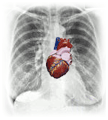|
Space
Technology Used to Detect and Treat Heart Disease
 Feb.
15, 1999--NASA's two-way communication technology, first used to
communicate with satellites, allows doctors to fine-tune a pacemaker
from outside the body to better regulate the heart rate in keeping
with the patient's lifestyle. But that's not all. NASA's electrode
technology, developed to monitor the heart rate of astronauts in
space, has led to exercise equipment that continually monitors the
user's heart rate and sets the machine's pace accordingly. Here's
more. In tests, NASA is using its high-speed transmission lines
to send medical data--technology that one day will help heart patients
in remote areas. Read these innovations and lots more. Feb.
15, 1999--NASA's two-way communication technology, first used to
communicate with satellites, allows doctors to fine-tune a pacemaker
from outside the body to better regulate the heart rate in keeping
with the patient's lifestyle. But that's not all. NASA's electrode
technology, developed to monitor the heart rate of astronauts in
space, has led to exercise equipment that continually monitors the
user's heart rate and sets the machine's pace accordingly. Here's
more. In tests, NASA is using its high-speed transmission lines
to send medical data--technology that one day will help heart patients
in remote areas. Read these innovations and lots more.
Free
Online Training Is Available for Acquisition Professionals
 The
General Services Administration's Federal Acquisition University
announced the first online, self-paced, self-directed contracting
officer representative (COR) training. The Cor Mentor is free to
both public and private sector acquisition professionals. The
General Services Administration's Federal Acquisition University
announced the first online, self-paced, self-directed contracting
officer representative (COR) training. The Cor Mentor is free to
both public and private sector acquisition professionals.
Apply
Online and Be Overseas by Summer
 Peace
Corps has many openings for volunteer positions beginning in the
summer of 1999, particularly for teachers or those with a liberal
arts degree and tutoring experience. Peace
Corps has many openings for volunteer positions beginning in the
summer of 1999, particularly for teachers or those with a liberal
arts degree and tutoring experience.
The
New National Atlas of the United States Covers It All
 October 2, 1998--Put aside your book maps and even
your CD-ROMs. More than a dozen federal agencies, led by the U.S.
Geological Survey, have produced an electronic product that will
make any mapmaker wannabe drool. You can produce your own maps,
featuring not only the standard terrain, roads, lakes, and rivers,
but also population, income, climate, historical evolution, whatever.
And of course you can zoom in on any locality you want, even your
own neighborhood. In other words, you can select, combine, symbolize,
and display data sets that interest only you. You will need the
latest version of your browser.
October 2, 1998--Put aside your book maps and even
your CD-ROMs. More than a dozen federal agencies, led by the U.S.
Geological Survey, have produced an electronic product that will
make any mapmaker wannabe drool. You can produce your own maps,
featuring not only the standard terrain, roads, lakes, and rivers,
but also population, income, climate, historical evolution, whatever.
And of course you can zoom in on any locality you want, even your
own neighborhood. In other words, you can select, combine, symbolize,
and display data sets that interest only you. You will need the
latest version of your browser.
|
In
This Issue
Space Technology for the Heart
Online
Acquisitions Training
Apply
Online for Peace Corps
National
Atlas Covers It All
Back
Issues
Vol.
1, No. 16, February 8, 1999
Vol.
1, No. 15, January 25, 1999
Vol.
1, No. 14, January 18, 1999
Vol.
1, No. 13, January 11, 1999
Vol.
1, No. 12, January 4, 1999
Past
Issue Archive
|
|


 Feb.
15, 1999--NASA's two-way communication technology, first used to
communicate with satellites, allows doctors to fine-tune a pacemaker
from outside the body to better regulate the heart rate in keeping
with the patient's lifestyle. But that's not all. NASA's electrode
technology, developed to monitor the heart rate of astronauts in
space, has led to exercise equipment that continually monitors the
user's heart rate and sets the machine's pace accordingly. Here's
more. In tests, NASA is using its high-speed transmission lines
to send medical data--technology that one day will help heart patients
in remote areas. Read these innovations and lots more.
Feb.
15, 1999--NASA's two-way communication technology, first used to
communicate with satellites, allows doctors to fine-tune a pacemaker
from outside the body to better regulate the heart rate in keeping
with the patient's lifestyle. But that's not all. NASA's electrode
technology, developed to monitor the heart rate of astronauts in
space, has led to exercise equipment that continually monitors the
user's heart rate and sets the machine's pace accordingly. Here's
more. In tests, NASA is using its high-speed transmission lines
to send medical data--technology that one day will help heart patients
in remote areas. Read these innovations and lots more.
 The
General Services Administration's Federal Acquisition University
announced the first online, self-paced, self-directed contracting
officer representative (COR) training. The Cor Mentor is free to
both public and private sector acquisition professionals.
The
General Services Administration's Federal Acquisition University
announced the first online, self-paced, self-directed contracting
officer representative (COR) training. The Cor Mentor is free to
both public and private sector acquisition professionals.
 Peace
Corps has many openings for volunteer positions beginning in the
summer of 1999, particularly for teachers or those with a liberal
arts degree and tutoring experience.
Peace
Corps has many openings for volunteer positions beginning in the
summer of 1999, particularly for teachers or those with a liberal
arts degree and tutoring experience.
 October 2, 1998--Put aside your book maps and even
your CD-ROMs. More than a dozen federal agencies, led by the U.S.
Geological Survey, have produced an electronic product that will
make any mapmaker wannabe drool. You can produce your own maps,
featuring not only the standard terrain, roads, lakes, and rivers,
but also population, income, climate, historical evolution, whatever.
And of course you can zoom in on any locality you want, even your
own neighborhood. In other words, you can select, combine, symbolize,
and display data sets that interest only you. You will need the
latest version of your browser.
October 2, 1998--Put aside your book maps and even
your CD-ROMs. More than a dozen federal agencies, led by the U.S.
Geological Survey, have produced an electronic product that will
make any mapmaker wannabe drool. You can produce your own maps,
featuring not only the standard terrain, roads, lakes, and rivers,
but also population, income, climate, historical evolution, whatever.
And of course you can zoom in on any locality you want, even your
own neighborhood. In other words, you can select, combine, symbolize,
and display data sets that interest only you. You will need the
latest version of your browser.